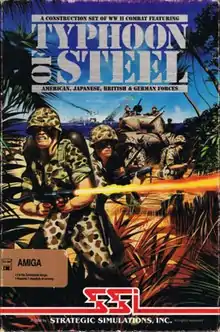Typhoon of Steel (video game)
Typhoon of Steel is a 1988 computer wargame designed by Gary Grigsby and published by Strategic Simulations Inc. (SSI). A follow-up to Grigsby's game Panzer Strike, it simulates military conflict during World War II.
| Typhoon of Steel | |
|---|---|
 Amiga cover art | |
| Developer(s) | Strategic Simulations |
| Publisher(s) | Strategic Simulations |
| Designer(s) | Gary Grigsby |
| Platform(s) | Apple II, Amiga, Commodore 64, DOS |
| Release | |
| Genre(s) | Computer wargame |
In 1989, Typhoon of Steel was followed by Overrun!, which features an updated version of its engine and mechanics.
Gameplay
Typhoon of Steel is a computer wargame that simulates military conflict during World War II, covering combat scenarios in the Asiatic-Pacific Theater and European Theatre. Alongside its pre-made scenarios, it features an editor that allows players to create hypothetical battles.[1] Typhoon of Steel contains a "Banzai" rule to impact games that get out of balance.[2]
Development
Typhoon of Steel was designed by Gary Grigsby and published by Strategic Simulations Inc. (SSI).[3] A sequel to Grigsby's game Panzer Strike,[4][1] it reuses that project's game engine and mechanics,[5] updated to focus on different sections of World War II. This design reuse followed a common trend for SSI titles at the time: the game systems of successful titles were often reused in subsequent products.[4] Like its predecessor, Typhoon of Steel debuted in 1988.[6]
Reception
M. Evan Brooks reviewed the game for Computer Gaming World, and stated that "for the dedicated gamer, Typhoon of Steel offers an engaging, albeit time-consuming, study of small unit actions during World War II in the South Pacific."[8]
In Computer Play, Russ Ceccola offered Typhoon of Steel a positive review and recommended it to "the serious war gamer".[4] Computer Gaming World nominated Typhoon of Steel for its "Wargame of the Year" award, which ultimately went to Battles of Napoleon.[9]
Reviewing the Amiga version, George Campbell of Strategy Plus dubbed Typhoon of Steel "an excellent game".[10] Zzap!'s reviewer considered the game flawed, but noted that it contained "a lot of worthwhile detail" and "plenty of ambition".[7]
Legacy
Typhoon of Steel was followed by Overrun!, which reused the game's mechanics and engine, updated to focus on modern warfare scenarios.[5]
In 1996, Computer Gaming World declared Typhoon of Steel the 143rd-best computer game ever released.[2]
References
- Katz, Arnie (February 1989). "Waging World War II: Military Simulations for Computers and Video Games". VideoGames & Computer Entertainment: 76–82.
- Staff (November 1996). "150 Best (and 50 Worst) Games of All Time". Computer Gaming World (148): 63–65, 68, 72, 74, 76, 78, 80, 84, 88, 90, 94, 98.
- Brooks, M. Evan (October 1993). "Brooks' Book Of Wargames: 1900-1950, R-Z". Computer Gaming World (111): 144–148.
- Ceccola, Russ (January 1989). "Another WWII Winner from SSI". Computer Play: 18, 20.
- Hogg, Robin (July 1989). "Overrun!". Zzap! (51): 61.
- Emrich, Alan (September 1995). "The Pioneering Spirit of a Wargame Guru". Computer Gaming World (134): 201, 202, 204.
- Staff (April 1991). "Typhoon of Steel". Zzap! (72): 28.
- Brooks, M. Evan (December 1988). "Banzai Strike Line: Pacific Theater Combat in "Typhoon of Steel"". Computer Gaming World. 1 (54): 32–34.
- Editorial Staff (October 1989). "Game of the Year Awards". Computer Gaming World (64): 8, 41, 42.
- Campbell, George (March 1991). "Strategy; Typhoon of Steel". Strategy Plus (6): 12, 13.